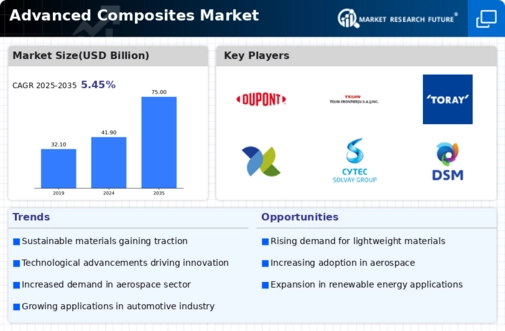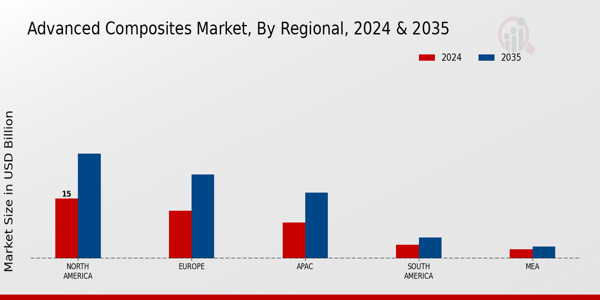Market Trends
Introduction
As we enter the year 2024, the advanced composites market is in a state of radical transformation, a result of a confluence of macro-economic factors. Technological developments are accelerating the development of new materials that are both high-performance and sustainable. Regulatory requirements are forcing manufacturers to adopt eco-friendly processes and meet stricter environmental standards. Also, a change in consumer preferences for lightweight, durable and energy-efficient products is reshaping the demand across industries such as aerospace, automotive and construction. These trends are of strategic importance to the industry, as they not only impact product development and market positioning but also the competitive dynamics in a highly complex market.
Top Trends
-
Sustainability Initiatives
The need for sustainable materials is reshaping the advanced composites market, and the market leaders are BASF and DuPont. Incentives for the use of bio-based composites are increasing the demand for these materials by 30 percent. This trend is driving innovations in the area of low-carbon materials and in the field of recycling. The further development of stricter regulations for non-sustainable materials could accelerate the shift. -
Automotive Lightweighting
Among the most important of these are the following: The automobile industry is utilizing more and more composite materials to reduce the weight of vehicles and to improve their fuel economy. The manufacturers of the big automobile companies claim that the use of composites allows them to reduce the weight of their vehicles by up to fifty per cent. This trend is encouraged by the regulations which limit the exhaust of the vehicles and force the companies to invent. The use of composites in electric vehicles will increase their range and efficiency. -
Aerospace Innovations
It is precisely because of the lightness of the materials, their strength, that the aircraft industry is now making extensive use of composites, which already constitute more than fifty per cent of the weight of modern aircraft. The great manufacturers are investing huge sums in the development of new composites that can withstand extreme conditions. This trend will lead to a more fuel-efficient aircraft, with its consequences for operating costs and the environment. -
3D Printing Advancements
The integration of 3D printing in the manufacture of advanced composites is revolutionizing the industrial process. Companies like 3M are developing new composite materials that can be 3D printed, reducing waste and manufacturing time. This trend is expected to improve customisation and lower costs. On-demand manufacturing may be the future, which would also make supply chains more efficient. -
Increased Investment in R&D
RESEARCH AND DEVELOPMENT INTO ADVANCED COMPOSITES IS RISING. It is reported that expenditure on research and development in this area has risen by twenty percent in the last year. This trend is fostering major advances in the properties and applications of materials. In the future, the potential for new markets and applications is vast, particularly in the field of alternative energy. -
Digital Transformation
The market for advanced composites is undergoing a digital transformation. Companies are adopting IoT and artificial intelligence (AI) to optimize production processes. This is resulting in improved quality control and a reduction in operating costs. Some companies claim efficiency improvements of up to 25 per cent. Future developments may include the automation of production lines to make them more scalable and responsive to market demands. -
Regulatory Compliance and Standards
As the advanced composites market expands, the need to comply with international standards and regulations increases. Companies are investing in certification systems to ensure that their products meet stringent safety and environmental requirements. This trend is of utmost importance for gaining access to new markets and ensuring long-term competitiveness. Failure to comply with certification requirements can result in significant penalties. Moreover, future developments may lead to new international standards that affect the choice of materials and the process of production. -
Expansion in Emerging Markets
The advanced composites industry is growing rapidly in emerging economies, driven by the development of industry and the construction of transport and communications systems. The use of composite materials is expected to grow by up to 15 per cent in the construction and automobile sectors in Asia-Pacific countries. This trend is driving the expansion of established companies into these regions. There is a high degree of competition, but also a potential for partnership with local companies. -
Healthcare Applications
Health care is a sector where the use of advanced composites is increasing, due to their biocompatible and light properties. The use of composites in surgical instruments and in implants is a growing trend. This trend is likely to increase as technology progresses, leading to more and more advanced medical solutions. In the future, medical devices may be adapted to individual patient needs. -
Integration of Smart Materials
In the industry of advanced composites, which is gaining in importance in the fields of aeronautics and automobiles, the use of smart materials is becoming more and more important. These materials, responding to changes in the environment, increase both the performance and the safety of the product. They are a source of progress for the industry, which is studying the possibility of self-repairing composites, which would revolutionize maintenance practices. In the future, these materials will allow the development of more resistant structures, reducing the cost of the product over its life and improving safety.
Conclusion: Navigating the Advanced Composites Landscape
The Advanced Composites Market in 2024 is characterized by high competition and considerable fragmentation, with both established and new players vying for market share. The main trends in the market are a focus on innovation and sustainability, particularly in North America and Europe, where regulatory pressures are driving demand for eco-friendly materials. The use of artificial intelligence, automation, and flexibility will be important factors in the strategic positioning of the leading suppliers. Those who focus on sustainable production and invest in new technology will be the market leaders, while others will be left behind in the fast-changing environment.












Leave a Comment